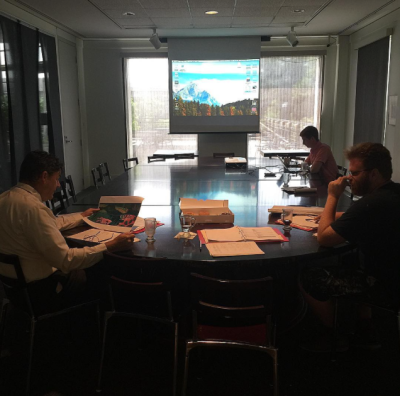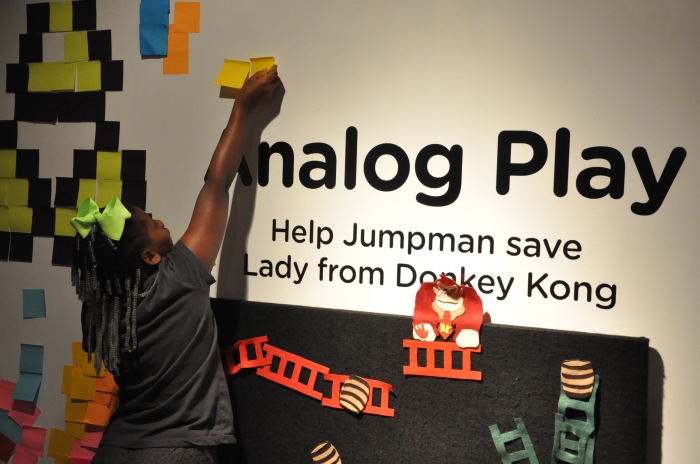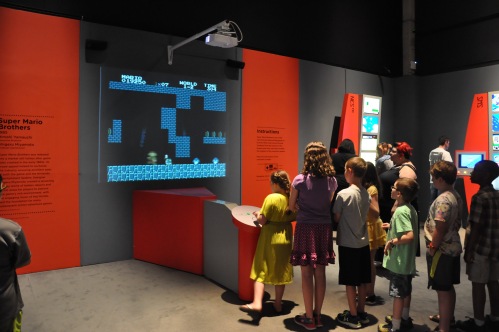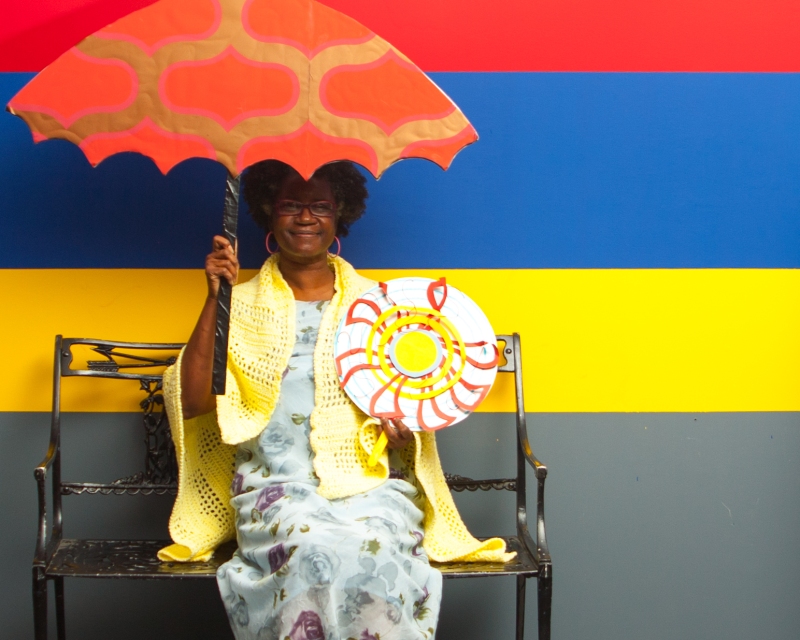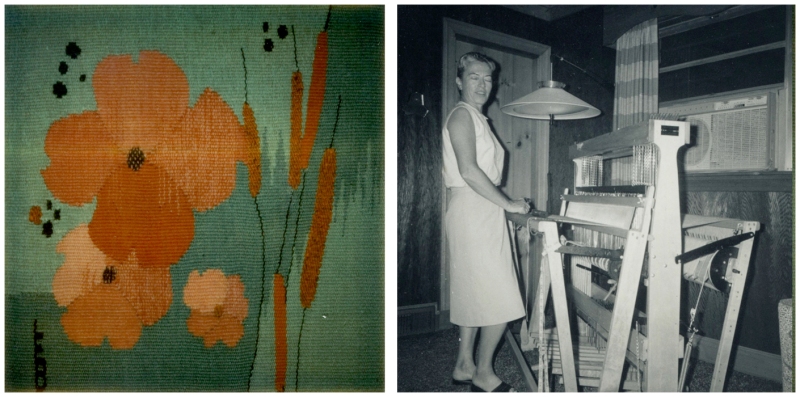Local artists collaborate for Brooks Museum mural installation
*Blog post written by marketing intern Eric Jones from Rhodes College.*
Buggin’ & Shruggin’: A Glitched History of Gaming Culture brings three local artists together under one roof to birth one consuming piece of two-dimesional genius.
For this collaboration, Memphis Brooks Museum of Art commissioned Michael Roy (Birdcap Shruggin’), Brandon Marshall (Nosey), and Lance Turner (Crackers) for what is described as, “the brain child of artist Michael Roy, [an] exhibition [that] features a series of murals which riff upon popular video games, major characters,and the gamers themselves.” The title’s inclusion of “buggin” (crazy) and “glitched” (flawed), suggests an irreverent approach to the subject matter. Bold forms, vivid colors, and mindbending combinations of people, machine parts, gears, animals, and architectural elements offer a delightfully twisted vision of gaming culture.
Outside of this installation, Michael Roy has worked closely with both Nosey and Lance on recent public projects around Memphis. Michael and Lance just finished a collaborative mural at Chelsea Avenue and Evergreen Street in Memphis for Paint Memphis.
Michael and Nosey recently cameoed in a Marc Gasol tribute video for the Grizzlies that featured them with their Gasol mural outside the Airways Flea Market in Orange Mound.
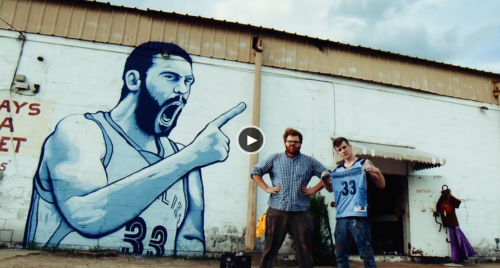
Credit: Marc Gasol of Memphis, Official Memphis Grizzlies website
These three artists and the others that contributed to Buggin’ and Shruggin’ similarly make noticeable community-minded work around town to make Memphians more aware of the local art scene and its presence in the city.
Their museum piece speaks not only to the space but to those who walk through it. The gallery sized mural creates a beautiful contrast with the rest of The Art of Video Games exhibition by using the lofted nostalgia of digital imagery and storytelling and turning it into a physical space that literally surrounds you.
“I love the explosive, overlapping, dreamllike qaulity! It’s pop, it’s psychodelic, it’s digital and analog, warm and cool. Thank you, thank you!,” one patron commented.
Many other comments acknowledged how well the exhibition made visitors feel young again or how impressive it was that the history of gaming could be repurposed as the history of an art form. Buggin’ and Shruggin’ certainly brings out the artistic passion that Birdcap, Nosey, and Crackers have for the subject matter. In addition, it conveys an interest that some of the museum’s recent visitors didn’t realize they had for the creativity of video games.
The collaboration of these local artists culminates in an installation that feels personal to the exhibit, the Brooks Museum, and any true video game lover.
To see more photos of the Buggin’ and Shruggin’ exhibition, click here.
Winners announced of Art of Minecraft Design & Build Contest

*Blog post written by marketing intern Eric Jones from Rhodes College.*
This summer, Brooks Museum challenged all Minecraft fanatics to design and build the world’s coolest and most creative art museum.
We received a resounding response: 251 entries across three age categories, including over 200 entries from ages 12 and under. Three judges, The Art of Video Games site curator Dr. Stanton Thomas and artists Michael Roy (Buggin & Shruggin: A Glitched History of Gaming Culture) and Kenneth Wayne Alexander II (Surreal Kingdoms), sifted through the submissions using four criteria: creativity of the museum name, creativity of the museum design, originality, and the entry description.
To quote Michael Roy, “It was a huge pleasure to get to see so much creativity involved in creating a museum. The only unhappy moment was having to pick such few winners when surrounded by so much great work!”
Michael’s words perfectly captured our feelings about this inagural event. We are eager to keep developing other ways to get all ages creatively involved with the Brooks Museum and ultimately excited about art.
- First place winners each received an $85 GameStop gift certificate and a family membership for a year to the Brooks Museum.
- Second prize winners received a $50 GameStop gift certificate and two Museum day passes.
- Third prize winners received a $25 GameStop gift certificate and two Museum day passes.
Art of Minecraft Design & Build Contest Results:
Ages 12 and under:
First place: Anna Clark (12), Senatobia, MS, The Jungle Art Museum
Second place: Mark Hieatt (11), Cordova, TN, Glass Dome Museum of Art
Third place: John Marston, Jr. (11), Memphis, TN, Marston’s Museum of Art
Ages 13 – 17:
First place: Alexander Rapp (17), Germantown, TN, Retro-Symmetry
Second place: Ethan Marek Ferguson (15), Cordova, TN, New Santorini
Third place: Samantha Barton (13), Atoka, TN, The Iris Art Museum of Awesomeness
Ages 18 and up:
First place: Will Merrell (35), Cordova, TN, All Natural Museum Inn
Second place: Robin Poche (37), Collierville, TN, La Musee Arc-en-ciel
Third place: Chris Carter (24), Millington, TN, The Art of Art
*Click on the photos to see the image full-size.*
The Art of Video Games is organized by the Smithsonian American Art Museum with generous support from the Entertainment Software Association Foundation; Sheila Duignan and Mike Wilkins; Shelby and Frederick Gans; Mark Lamia; Ray Muzyka and Greg Zeschuk; Rose Family Foundation; Betty and Lloyd Schermer; and Neil Young. The C.F. Foundation in Atlanta supports the museum’s traveling exhibition program, Treasures to Go.
Wacky Wednesdays: Free, fun, family-friendly summer event series
Are you looking for something to get your kids out of the house during the summer break? Join us at Memphis Brooks Museum of Art for a free, fun, family-friendly summer of art and film in our Wacky Wednesday Summer Series.
Every Wednesday from 10 am until 12 pm in June and July, independent and international children’s short films and animated versions of beloved classics are shown in the Brooks auditorium. Families also have the opportunity to make art together in our drop-in studio.
Several of the films are made by independent animators and directors from all over the world and are movies children rarely get to see.
The children’s short films July schedule:
- Wednesday, July 1
- Morningbird and Murmelton on Winter Holiday (Norway), One Cool Friend (USA), Wild About Books (USA), Walkin’ the Dog (Hungary), The Dot (USA), Bitseller (Spain).
- Wednesday, July 8
- Planting a Rainbow (USA), My Garden (USA), Linnea in Monet’s Garden (USA).
- Wednesday, July 15
- The Curious Garden (USA), Pet Show! (USA), Tumble Leaf: Shiny Coins and Tumble Leaf: Fig Finds a Shadow, Relax (USA), Hooray for Amanda and Her Alligator (USA).
- Wednesday, July 22
- Giraffes Can’t Dance (USA), Elizabeti’s Doll (USA), The Trompeteer (Mexico), Ada and Otto (Estonia).
- Wednesday, July 29
- The Elephant and the Bicycle (Belgium/France), The Present (Germany), Fresh Out of School (France), Silent (USA), A Picture for Harold’s Room (USA),The Trip (USA), Extra Yarn (USA).
Previouly shown films:
- Wednesday, June 3
- Cloudette (USA, 2013), The Mobile (Mexico), Zebra (Germany), Art (USA), Harold and the Purple Crayon (USA), Sandra Boynton’s Alligator Stroll (USA), Super Spiny Shiny Grocey Store (Taiwan).
- Wednesday, June 10
- Little Matryoshka (Turkey), Where the Wild Things Are (USA), Chicka Chicka Boom Boom (USA), Crazy Hair Day (USA), Leonardo the Terrible Monster (USA).
- Wednesday, June 17
- The Ant and the Grasshopper (USA), Antarctic Antics (USA), The Pink Helmet Posse (USA), Decorations (Japan).
- Wednesday, June 24
- The Magic Ferret (Canada), How Shammies Were Getting Married (Latvia), Birdwatching (Portugal), All the Colors of the Earth (USA), Little Ruddy (Latvia).
This summer is really special as we explore play and art and celebrate our special exhibition the Art of Video Games. There is an interactive gallery space just for kids!

Families in the interactive gallery during a Wacky Wednesday event. (Source: Memphis Brooks Museum of Art)
Wacky Wednesdays are very popular and usually bring in a large crowd, so keep that in mind!
Our Wacky Wednesday series provides a creative outlet during the summer for families, as well as, day camps and child care centers.
As a reminder, if you are part of a daycare center for school, every visit to Brooks Museum is free as long as you make reservations. Click here for more information.
Wacky Wednesdays are open for groups of up to 60 students, and one chaperone is required for every eight students. All our galleries are open for kids to explore during and after the events happening downstairs.
Your family is always welcome at The Brushmark Restaurant, but we are asking you to help us preserve the artwork by not bringing in outside food and drinks. Click here to see the children’s menu.
Click here to learn more about Brooks Museum’s events for kids and families.
Wacky Wednesdays Summer Series is sponsored by Thomas & Betts.
The Art of Video Games is organized by the Smithsonian American Art Museum with generous support from the Entertainment Software Association Foundation; Sheila Duignan and Mike Wilkins; Shelby and Frederick Gans; Mark Lamia; Ray Muzyka and Greg Zeschuk; Rose Family Foundation; Betty and Lloyd Schermer; and Neil Young. The C.F. Foundation in Atlanta supports the museum’s traveling exhibition program, Treasures to Go.
The Art of Video Games plays on at Memphis Brooks Museum of Art
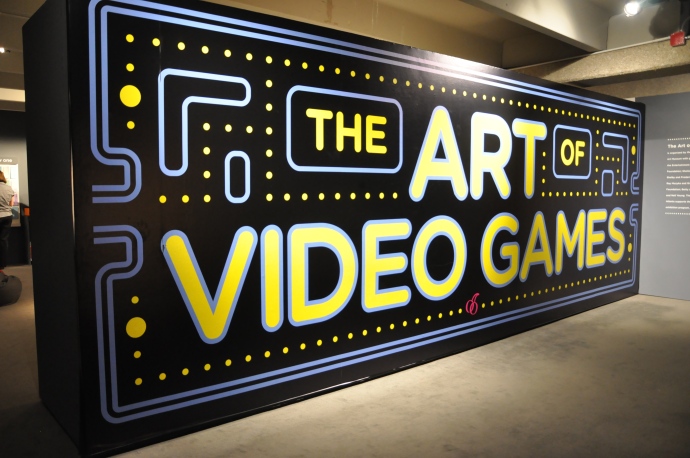
The entrance to the Art of Video Games exhibition at the Brooks Museum. (Source: Memphis Brooks Museum of Art)
(MEMPHIS, TN) – Have you ever considered Pac-Man or Super Mario Brothers art? A new exhibition visiting the Memphis Brooks Museum of Art is stretching the “traditional” definition of art.
The Art of Video Games is a traveling exhibition from the Smithsonian American Art Museum that explores the evolution of home video games during the past 40 years. Home video games combines traditional art forms such as painting, writing, sculpture, music, and storytelling. Video games also provide a new way of communicating with several different audiences.
The Art of Video Games features 20 different gaming systems from the 1970s Atari VCS to the modern Playstation 3. The SAAM and Chris Melissinos, founder of Past Pixels and collector of video games and gaming systems, planned the exhibition together. Melissinos selected 240 games he felt reflected the artistic potential of the medium. He then conducted a public poll to help determine games the public considered to be most important and influential. Nearly 120,000 people from 175 countries participated in the poll and 3.7 million votes were cast for their favorite video games.

Visitors interacting with the Art of Video Games exhibition at the Brooks Museum. (Source: Memphis Brooks Museum of Art)
A total of 85 examples were selected which demonstrates the evolution of video games. During the exhibition’s inaugural run at the Smithsonian American Art Museum, more than 680,000 people toured the exhibition. The exhibition features the games through still images, videos, video interviews with developers and artists, large prints of in-game screenshots, and game consoles.
“Everyone who plays a game puts a little of themselves into the experiences, and takes away something that is wholly unique,” says Melissinos, who is also the curator of the exhibition. “This conversation among the game, the artist, and the player is critical to understanding video games as art.”
Five games from each era of video game evolution are featured and are playable at the exhibit. Visitors will get the chance to relive their childhood and share their favorite games with a younger generation. These five featured games are Pac-Man, Super Mario Brothers, The Secret of Monkey Island, Myst, and Flower.
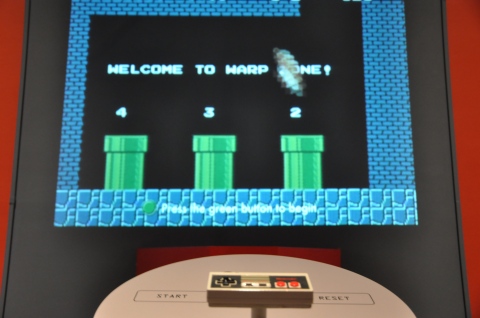
Visitors can play Super Mario Brothers at the featured exhibition at the Brooks Museum. (Source: Memphis Brooks Museum of Art)
The Art of Video Games is being featured at the Memphis Brooks Museum of Art beginning Saturday, June 6. Visitors and museum members have until September 13, 2015 to open their minds to a new art form – the art of video games.
The Art of Video Games is organized by the Smithsonian American Art Museum with generous support from the Entertainment Software Association Foundation; Sheila Duignan and Mike Wilkins; Shelby and Frederick Gans; Mark Lamia; Ray Muzyka and Greg Zeschuk; Rose Family Foundation; Betty and Lloyd Schermer; and Neil Young. The C.F. Foundation in Atlanta supports the museum’s traveling exhibition program, Treasures to Go.
Activist Photographers of Today
This post was written by Sadie Yankello, Rhodes College Intern, in February 2015.
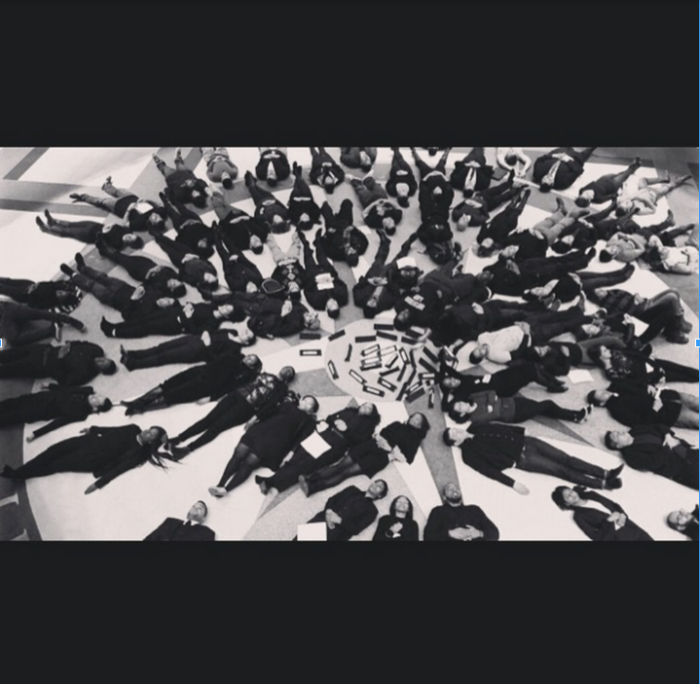
“Die In” activism is still present on social media, as Rutgers Law students are captured in this Instagram from January 2015.
The power of peaceful protest has not been lost. And as we have seen in the exhibition This Light of Ours: Activist Photographers of the Civil Rights Movement, photography is an indispensable means by which these moments–personal, powerful, and historical–can be captured. While we may have moved from film canisters to memory cards, documenting non-violent protest is no less relevant for our generation. Although some mass media outlets tended to focus on violent protests that have occurred in Ferguson since August, social media movements offer a grassroots telling of the non-violent activism.
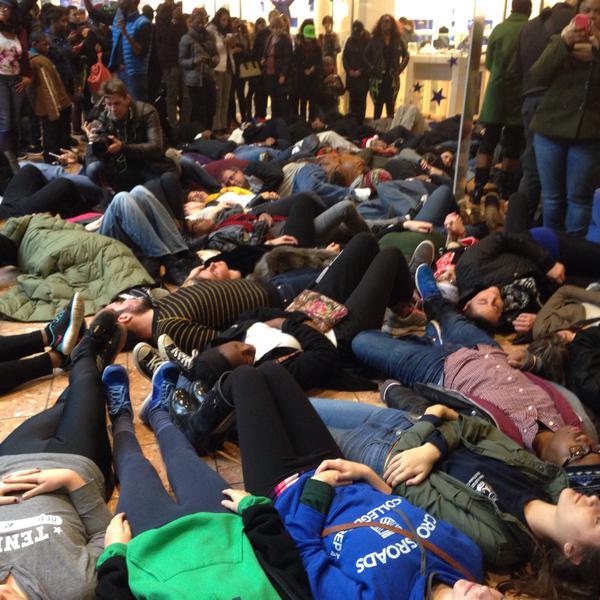
An Instagram post of the “Die In” that occurred at Saint Louis Galleria shopping mall on Black Friday.
After the shooting of Michael Brown this past August, social media has been a means of organizing protests and activism. For example, multitudes of demonstrators organized via social media using the hashtags #notOneDime, #BlackLivesMatter, and #STLBlackFriday. The pictures captured of the huge groups of demonstrators playing dead are incredibly powerful and spread like wildfire on social media. Numerous other mass “die ins,” peaceful walks and marches, and thought provoking quotes can be found using these hashtags among others. Hashtags fuel the peaceful protest because they can help people organize, educate, and most importantly bring direct attention to major events and demonstrations. They are a way for people who are not present to remain informed, and involved, as they spur demonstrations in other areas. For example, the viral videos, Instagram images, and tweets from Saint Louis die-ins, spurred die-ins nationwide. There was even one at the National Civil Rights Museum here in Memphis.
The social media outcry in 2014 has common footing with the demands for equality found in the Civil Rights Movement of the 1960s. While the activist photographers of the 1960s were able to document the powerful protest happening at the time, social media can instantaneously echo and inform the public on what activist are doing on a daily basis. Their message and impact can be spread further, and faster. Imagine if the civil rights activists photographers had Twitter and Instagram, their powerful photos would have been able to spread courage, pride, and righteousness around the globe at the speed of light.

Matt Herron photograph of the Rev.Martin Luther King Jr. leading singing marchers from Selma to Montgomery in 1965.
© Matt Herron.
Learn more about This Light of Ours: Activist Photographers of the Civil Rights Movement
Shine Your Light on the World: Sonic Visionaries in African American Music
This post was written by Zandria F. Robinson, Assistant Professor of Sociology, The University of Memphis; Blogger, New South Negress; and author of This Ain’t Chicago: Race, Class, and Regional Identity in the Post-Soul South (University of North Carolina Press, 2014)
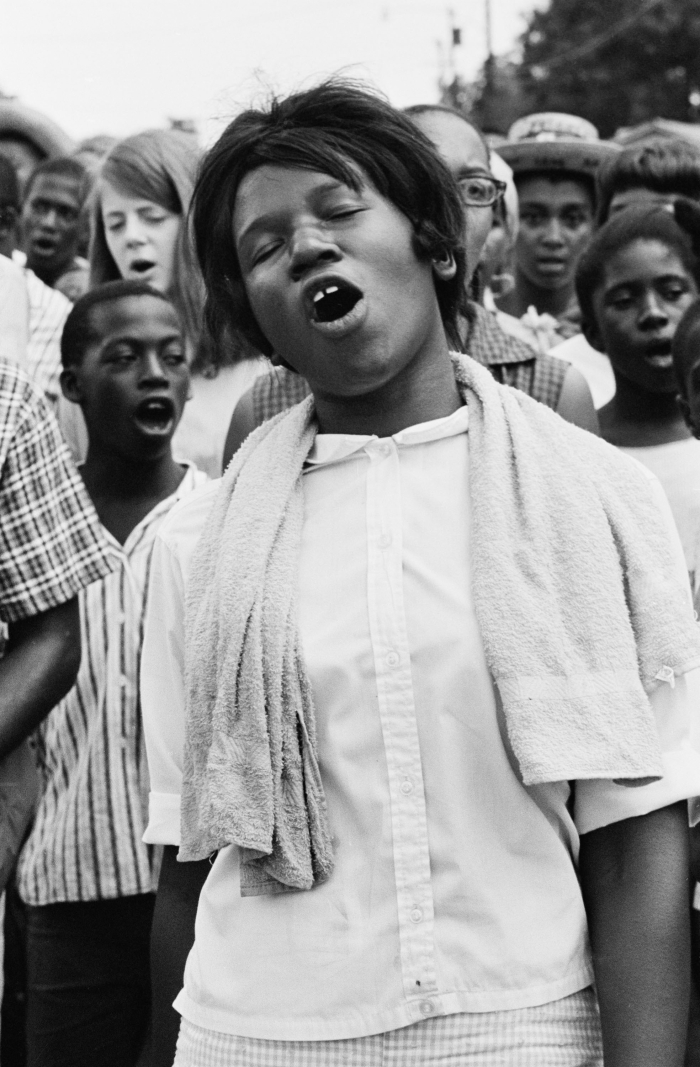
March participants sing during a Deacons of Defense march through Bogalusa. Song was the glue that helped hold the civil rights community together. It fostered courage in times of danger, solidarity in times of stress. Matt Herron Bogalusa, Louisiana, 1965
this little light of mine
i’m gonna let it shine
shine bright like a diamond
umi says shine your light on the world
shine your light for the world to see.
turn on the lights in here baby
extra bright i wan’t y’all to see this
turn on the lights in here baby
you know what i need
want you to see everything
want you to see all of the lights
some people recognize the light
but they can’t handle the glare
we feel that we have a responsibility to shine the light
This Light of Ours: Activist Photographers of the Civil Rights Movement visually chronicles a critical moment in the modern African American struggle for freedom, highlighting how a diverse group of photographers used their lenses to capture the intersection of humanity and struggle. Photography is one of several mediums, along with sculpture, visual art, literature, and music, that African Americans have used to uncover obscured histories and speak back to oppression, holding America accountable for its promises and ideals of freedom and equality. Of these media, music has some of the most flexibility, employing narrative, sonic, and visual strategies to shine the light on inequality. As the soundtrack of protest and a site for theorizing black humanity and freedom, African American music turns on “all of the lights” to provide a vision for action and a more just future.
In African American music, light is often a metaphor for the labor of black activism, for the articulation of black humanity, and as marginalized people’s primary weapon against oppression. The iconic “This Little Light of Mine,” a black Sunday School staple across the country, is one of the most widespread uses of light as a metaphor for the fullness of black humanity and talent. Its popularity as a children’s song demonstrates its use in the racial socialization of children, instilling pride in one’s gifts even in a society that denies their existence. The narrator in “This Little Light of Mine” resolves to “let” her or his light shine, suggesting that one might turn off, hide, or shield a light; thus, letting it shine is a deliberate and purposeful act. While the song’s original meaning might have been to encourage children to let their light shine in service of God, African Americans added additional layers of meaning. In addition to its relative simplicity, spirited tempo, and major key, the song’s narrative has obvious appeal to people who were compelled to hide their lights—their intelligence, literacy, skill, beauty—lest they suffer terribly or lose their lives at the hands of whites. Thus, as a post-Emancipation theme, the song served as an articulation of resistance, as a refusal to bracket parts of one’s humanity in order to fit into an unjust social order.
Demands to shine one’s light, as well to shine a light on oppression, echo throughout African American music, a constant reminder to embrace and assert one’s humanity in a social context where such humanity is perpetually denied. Often black love is a transgressive space where one is encouraged to shine her or his light, again despite structures and policies that are disruptive to black love. For instance, at first blush, Rihanna’s 2012 song “Diamonds” seems like a typical pop love anthem. Yet, read through the metaphor of light in African American songs, “Diamonds” is an affirmation of black love—“shine bright tonight/you and I/we’re beautiful like diamonds in the sky”—punctuated by the repeated directive refrain: “shine bright like a diamond/shine bright like a diamond/shine bright like a diamond.” Similarly, Common’s “The Light,” which samples a phrase from Bobby Caldwell’s “Open Your Eyes,” insists that, “there is a light that shines, special for you and me.” Common also argues that “some people recognize your light/but they can’t handle the glare,” which is both an assertion about a partner’s inability to appreciate one’s talents and a larger comment on black brightness. Here, the encouragement to shine one’s light does not come from one’s religious racial socialization, but from an intimate, though not necessarily romantic, love from one person to another.
As heir to the protest music of the Civil Rights Movement, hip-hop is replete with references to light as both an assertion of humanity and a weapon against oppression. With a cello introduction and triumphant synthesized trumpet melody, Kanye West’s “All of the Lights” is a call to action that implores us to turn on all lights extra bright—cop lights, flashlights, spotlights, strobe lights, and street lights. “I want y’all to see this,” Rihanna, as guest vocalist, sings, “you know what I need/want you to see everything/want you to see all of the lights.” This demand for the shining of lights is reminiscent of Mamie Till’s decision to shine the light on what had been done to her son Emmett by Roy Bryant, J. W. Milam, and still unknown accomplices in Money, Mississippi in 1955. Emmett Till’s mangled body was displayed in an open casket during his Chicago funeral, and pictures of his mutilation appeared in a September 1995 issues of Jet magazine. Like the disruption and awakening caused by these images, the official video for “All of the Lights” uses a variety of jarring light effects, reflecting the difficulty of shining the light on American inequality. Often maligned for its obscenity and vulgarity, hip-hop endeavors to shine the light on the vulgarity of inequality for everyone to see.
Rapper Yasiin Bey’s (Mos Def) corpus contains some of the most important ruminations on light in hip-hop. In conjunction with rapper Talib Kweli, Bey formed the duo “Black Star,” which in itself is a nod to the intersection of race and light. In the intro to the duo’s only album, Mos Def and Talib Kweli Are Black Star, a male narrator says, “We feel we have the responsibility to shine the light into the darkness.” Remix genius Amerigo Gazaway’s work reads Bey’s corpus as an extended dialogue with Marvin Gaye, whose movement music reflected and galvanized a generation frustrated with persistent economic and racial inequality. In “Modern Marvel,” a song from his album The New Danger, Bey samples Marvin Gaye’s “What’s Going On” and declares, “I’m so black I’m bright/I’m so bright I’m black/shine through the darkness night,” equating blackness itself with light.
In one of his most widely popular songs, “Umi Says,” Bey returns to themes voiced a century earlier in “This Little Light of Mine.” His umi and abi, mother and father in Arabic, as well as his elders, have told him to shine his light on the world. “Umi said shine your light on the world/shine your light for the world to see/my abi said shine your light on the world/shine your light for the world to see.” This light shining is punctuated by the repetition of a simple existential desire: “I want my people to be free, to be free, to be free/I want black people to be free, to be free.” Blackness, freedom, love, and active light become the centerpieces of transhistorical black struggles for freedom from the slave trade to present.
Black activists have always endeavored to shine the light on injustice, marshaling various means, from the pen to the camera to the courts, to speak back to systems of inequality. Regardless of the medium, light is the tool for affirming one’s humanity and making visible unjust structures that continue to constrain African American life chances. By marshaling light as a tool, black life becomes both light and freedom. As such, black people are responsible—to their parents, ancestors, themselves, each other, and to God—to shine the(ir) light on the world on the pathway to freedom.
Learn more about This Light of Ours: Activist Photographers of the Civil Rights Movement
Brooks + Memphis Urban League Young Professionals
The National Urban League is the nation’s oldest and largest community-based movement devoted to empowering underserved communities. It began in 1910, when Dr. George Edmund Haynes and Ruth Standish Baldwin–a Black man and White woman–found themselves both “deeply concerned about the health and welfare of the African-American migrants,” They started the Committee on Urban Conditions among Negroes (CUAN) in New York City, for those who moved north to escape segregation but did not escape implicit bias as Black newcomers in White urban centers. The charge of CUAN was to help those succeed. Like minded organizations joined the Committee, growing it to 81 members in 30 cities by the end of World War I (the named changed to the National Urban League in 1920). Currently, the National Urban League has 95 affiliates in 300 communities and 35 states, and provides services that have a positive impact on more than 2 million people nationwide.
With pivotal roles throughout the entirety of the 20th-Century Freedom Movement, you can imagine the Urban League’s imprint on the Civil Rights Movement. As a full partner in the movement unable to protest (in order to keep a tax-exempt status) the League worked to nurturing future leaders and activists, efforts which continue today.
The Memphis Urban League Young Professional (MULYP), a local auxiliary of the National Urban League, supports the development of young professionals in Memphis and serves through community action in areas of: financial literacy, youth mentoring, civic engagement, and various forms of advocacy. The same grassroots approach employed by the National Urban League and Civil Rights Movement is at work in MULYP, as they move to attract and retain the future leaders of the city of Memphis. MULYP Social & Cultural Chair Rhonnie Brewer:
“As young leaders it is paramount that we walk the path of where we have been in order to appreciate the journey of where we are going. For those who have come before us, their plight for civil rights was fought on the front lines of Selma, Alabama, or marching through the streets of Memphis. Our generation’s plight is fought in boardrooms, in our artistic expressions or even in the halls of colleges and universities.”
The Memphis Urban League Young Professionals, in conjunction with This Light of Ours: Activist Photographers of the Civil Rights Movement, has partnered with the Brooks to bring a unique film series to the museum. This series aims to “encompass the struggles of past generations, yet relate to the challenges of the current generation, creating symmetry between past and present.”
For full series information visit Brooks + Memphis Urban League Young Professionals
This Light of Ours: Activist Photographers of the Civil Rights Movement

Standing (top row L-R ) Chester Collins, Elaine L. Turner, Gwen Glover, David M., Ed Smith, TC Heard Seated (L-R) Johnnie R. Turner, Grace Austin Meacham Several local community members who were active in the Civil Rights Movement attended the opening of the exhibition, including these LeMoyne students who protested the segregation of the Brooks Museum in 1960.
On February 1, 1960, four Black students refused to leave a Woolworth’s lunch counter after being denied service. Over 24 more students came the next day along with a TV reporter. As the image of the students seated at the lunch counter spread around the country, so did sit-ins. On June 25th of that year, Woolworth’s was forced to desegregate their lunch counter. Policy changed; the “sit-in” was born.
This Light of Ours: Activist Photographers of the Civil Rights Movement is an exhibition of photographs taken during the Southern Freedom Movement. Organized by the Center for Documentary Expression and Art in Salt Lake City, Utah, it is on view at the Brooks through May 10, reaching Memphis during the 50th year anniversary of the Voting Rights Act, and 55 years after the legendary Woolworth’s lunch counter sit-in. Although you won’t see an image of efforts to integrate lunch counters in the exhibition, you could say that the sit-in indirectly inspired every image you will see: most of the photos on view were taken by members of the Student Nonviolent Coordinating Committee, a group that formed after and was inspired by the sit-ins that spread across the country.
The Brooks is pleased to bring this exhibition to Memphis during such an important time of remembrance. Recent news events have launched social justice issues to the forefront of public discourse, and there is no better place than a museum to host and nurture these conversations. We brought in many community members to help us plan public programming to offer throughout the next few months. Take advantage. Bring your friends, family, coworkers, and thoughts.
Learn more about This Light of Ours: Activist Photographers of the Civil Rights Movement
Upcoming events
2014 in Review at the Memphis Brooks Museum of Art
A look back on a year of exhibitions at the museum
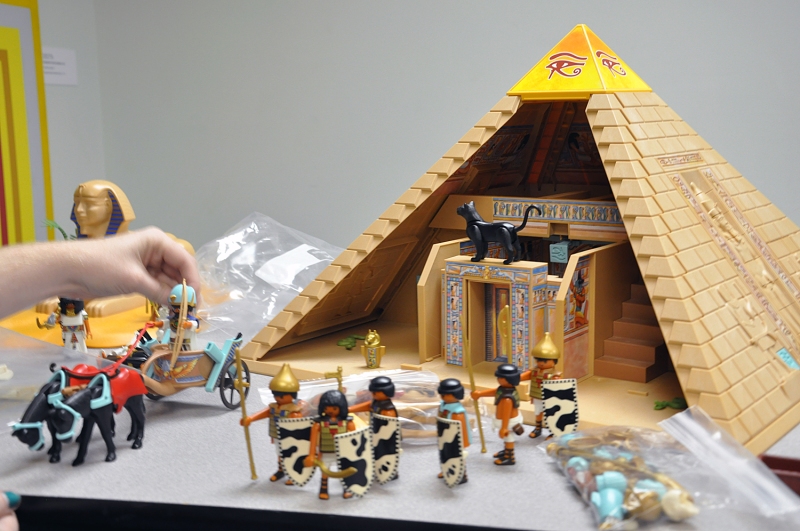
Memphis Brooks Museum of Art, Interactive Gallery preparation with students from Memphis College of Art
We started 2014 with pyramids on this blog and pyramids is how we will end it. Last January we mentioned the Pyramids of Giza in conjunction with a photography exhibition and how, in 1982, the pyramids were moved closer together (digitally) in a photograph to better fit on the cover of National Geographic magazine. This was done without the consent of the photographer, and provides an early example of a photo-manipulation faux pas. The exhibition we had on view, Shared Vision: The Sondra Gilman and Celso Gonzalez-Falla Collection of Photography, provided examples of this kind of pre-Photoshop handiwork without having to be labeled a misstep. Photographers such as David Levinthal and Vik Muniz reminded us that “throughout the short history of the medium, photographs have been staged, fabricated, and manipulated.”
Tricky enough to fool Sir Arthur Conan Doyle of Sherlock Holmes fame into believing in faeries and powerful enough to be a propaganda tool everyone should be the wiser of–all the while, photographs have been a legitimate art medium, no matter if the mass public has some form of the technology at their fingertips. Sure, not all Instagram photography is art, but that doesn’t mean that it can’t be. So last January along with Shared Vision we staged #MemphisShared, an exhibition of Instagram photography; if for no other reason than to stir up conversation about the state of photography–an endlessly interesting topic.
It is due to our current exhibition, Soulful Creatures: Animal Mummies in Ancient Egypt, that we mention pyramids now. On view through January 18, 2015, this exhibition includes artifacts and animal mummies from Egypt, as well as x-rays and research materials from the Brooklyn Museum. Of course with our city’s namesake pyramids are never far from mind, and the city of Memphis, Tennessee has its own Egyptology experts. In fact, the Institute of Egyptian Art and Anthropology at the University of Memphis received international acclaim with the discovery of a new tomb, a few feet away from Tutankhamen’s tomb, in 2006.
Men–Nopher, called Memphis by the Greeks, meant, to the early Egyptians, “Good Abode,” and the city of Memphis has been a good abode to the Brooks Museum: the past year brought many changes, and more are coming. In 2016, the museum will have been in Overton Park for 100 years. Part of the museum mission is to bring varied exhibitions to Memphis, and we are proud to have brought the work of Marisol to the city this past summer, a great post-war American artist obscured by history. Chief Curator Marina Pacini saw her career project realized in this exhibition, titled Marisol: Sculptures and Works on Paper, which traveled to El Museo de Barrio, New York’s leading Latino cultural institute, where it is on view until January 10. Not only did this exhibition introduce Marisol to Memphis, it reintroduced Marisol to the world. The results of this effort can be seen online by searching #MeetMarisol.
Another major exhibition of 2014 was Dalí: Illustrating the Surreal, a collection of 49 rare book illustrations by the celebrated and sometimes controversial Salvador Dalí. Hans Christian Andersen’s Fairy Tales, Lewis Carroll’s Alice in Wonderland, and Miguel de Cervante’s Don Quixote were amongst the tales told through Dalí’s masterful illustrations. We should keep the protagonist of Cervante’s work in mind as we push forward into 2015: Alonso Quixano was an adventurer, a little bit crazy, but whose mission to right the wrongs of the world, restore humanity, and inspire forceful social change, is one we all need to hear right now.

After the Ku Klux Klan burned this cross in front of a Mississippi Delta Freedom House, a civil rights worker transformed it with a painted message. Tamio Wakayama Indianola, Mississippi, 1964
With that in mind, this month brings a remarkable opportunity to experience the Civil Rights Movement through the eyes of those who lived it. This Light of Ours: Activist Photographers of the Civil Rights Movement opens to the public on January 14. Over the past few months, Brooks staff members have met with community leaders to develop a way to interpret these photographs in an impactful way that is relevant to now. We invite you to sit in with us on a number of unique opportunities. It is our hope that the exhibition and programs we have planned will help prepare Memphis and the world for a brighter tomorrow.
ABC: A Museum-School Program does “Rococo Subversive”
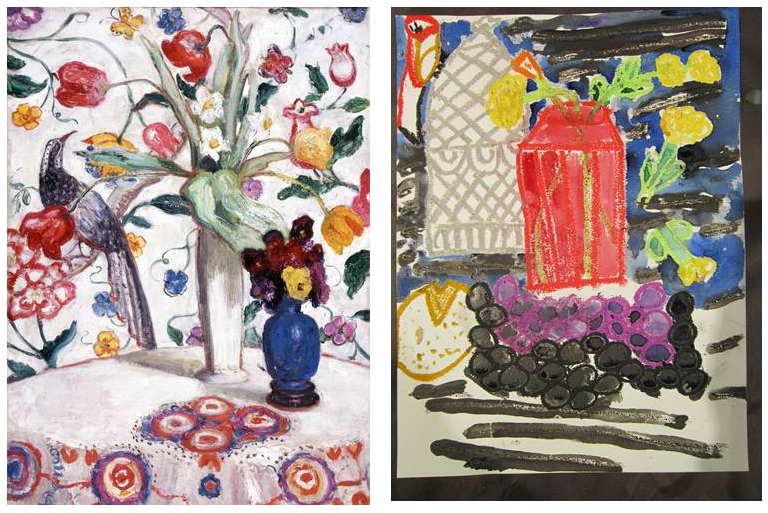
Left: Florine Stettheimer, American, 1871 – 1944,
Still Life Number One with Flowers (Flowers Against Wallpaper),
ca. 1915, Oil on canvas, Memphis Brooks Museum of Art, Memphis, TN;
Gift of the Estate of Miss Ettie Stettheimer 60.21
Right: Student work from Kingsbury Elementary
Last week, Art Builds Creativity (ABC) program participants wrapped their first museum visit of the school year. Students studied Florine Stettheimer’s Still Life Number One with Flowers and created their own still life based on the painting in the studio. The ABC program (formally known as Art and the Basic Curriculum) is a visual art enrichment program available to fourth grade classes at Title I schools in Memphis. It provides quality art education and an authentic museum experience to students and teachers in Memphis, and has been doing so since 1979. Today, the goals of ABC are to increase creativity skills and reinforce language arts skills recommended by participating teachers. Continue reading
Lions and Crocodiles and (Kitty) Cats, Oh My! Animals and Animal Mummies in Ancient Egypt

George checking out a book on Impressionism before taking it into the bathroom at a bookstore. (Note the kitty cat.)
“Do not laugh at a cat,” Dr. Patricia Podzorski, Curator of Egyptian Art at the University of Memphis advised me through email late Tuesday; this immediately brought to mind an incident earlier in the week, with my cat Thomas so embarrassed–dashing out of the room, when his ambitious relocation fail was met by my fits of laughter.
The advice came by way of “The Instruction of Ankhsheshonq,” a text consisting of pragmatic and humorous maxims on a variety of topics tentatively dating to the Ptolemaic period: think bathroom reading without all the indoor plumbing. Dr. Podzorski went on to offer other suggestions for translation she thought better suited to a cat’s temperament: do not “sport with,” “torment,” or “annoy.” But my Thomas had sent a clear message: it was the laughter he did not approve of. Cats have a “sense of persona–and become visibly embarrassed when reality punctures their dignity,” writes Camille Paglia in her epic Sexual Personae. (Maybe this is why cats and the internet go so well together, we can laugh about their punctured reality without embarrassing them in real life.)
The cat was domesticated by man over 4000 years ago in ancient Egypt, and its mummified body has been found all over the area. The complex and unique relationship between animals and the ancient Egyptians doesn’t end there. Dr. Podzorski will shed light on this topic and guide a tour of the Brooks’ foster mummies this Saturday, December 6, at 2 pm.
Brooks Announces Major Acquisition Bequest
Throughout the ages the path of the weaver has been the path of true civilization… there where the loom is waiting, the night of savagery is over.
The quote is from the brochure for The Path of the Weaver, an exhibition mounted at the Brooks Memorial Art Gallery (as the Memphis Brooks Museum of Art was known at the time) in 1978. Among the individuals given a prize was Eva Bernhardt—it was just one of many awards she received. Mrs. Bernhardt studied under Henry Easterwood at the Memphis Academy of Arts (today Memphis College of Art) and went on to teach weaving at the college between 1972 and the early 80s. An accomplished artist, her work was exhibited at Arkansas Art Center, Mint Museum, Speed Museum, and the Memphis Brooks Museum of Art, and she won many prizes and awards. Like Easterwood, she worked in a variety of styles from abstract florals in bright colors to geometric shapes in more mute earth tones.
A native New Yorker, Mrs. Bernhardt lived in Memphis for many years as her husband Herman served as a physician at the Veteran’s Hospital. Before taking up weaving, she taught biology and, as part of the Women’s Army Corp, served as a tail gunner trainer during World War II.
The Brooks is deeply grateful to Mrs. Bernhardt who generously left a bequest specifically for the acquisition of works of art for the permanent collection.
Someone call the Dog Police: William Wegman Videos on View

William Wegman let the dogs out.
Before William Wegman shot the large format photographs of Weimaraner dogs that would win him—and his subjects—mass acclaim, he created equally playful and imaginative short video works. In 1970, despite having graduated with an MFA in painting and printmaking from the University of Illinois at Urbana-Champaign, Wegman was one of the many artists who proclaimed that the medium of painting was “dead.” Throughout the early 70s, artists would find their antidote in Minimalism, Conceptual art, Body art/Performance, and Post-minimalism. Wegman responded by moving to California, buying a dog, and making video art.
Borrowing from all of the prevailing styles while claiming none, Wegman made over a thousand videos between 1970 and 1978, all averaging a minute long. His mock commercials, absurdist demonstrations, impersonations, send-ups, and pseudo-confessionals took from the mass communication visible on television screens across America, as the 60s dream of a utopian future faded from public consciousness. With all the trappings of a new era in art and culture and a “smart / dumb” eloquence, Wegman had only to start the reel and to see what happened. Like an ingenious child alone in his room and struck by boredom, Wegman improvised with the props at hand: inanimate objects, his body, and his first dog, Man Ray. He threw off the decade’s sense of foreboding with sight gags, double-binds, and visual clichés executed in pitch perfect deadpan humor. In unscripted, unedited videos shot in real time and using only actual sound, Wegman rendered the cosmic joke as a doodle.
William Wegman’s Video Works, 1970-74, on loan from Dr. James K. Patterson, will screen continuously in the Brooks’ Orientation Theater, entry level, through January 10, 2015.
Memphis Brooks Museum of Art Announces Search to Identify New Director
Esteemed Phillips Oppenheim Firm to Lead Search
Memphis, TN (September 25, 2014) — Nathan Bicks, President of the Board of Trustees of the Memphis Brooks Museum of Art, announced today that a search committee has been formed and that the Phillips Oppenheim firm of New York City has been selected to lead the search for the new Director of Memphis Brooks Museum, replacing Cameron Kitchin, who leaves the position on September 26. Continue reading
Meet Marisol Photo Booth

Saturday was Community Day at the Brooks; the theme “Meet Marisol” was complete with a photobooth for visitors to recreate Marisol’s Mi Mama Y Yo in any way they see fit. Here are the results: Continue reading




